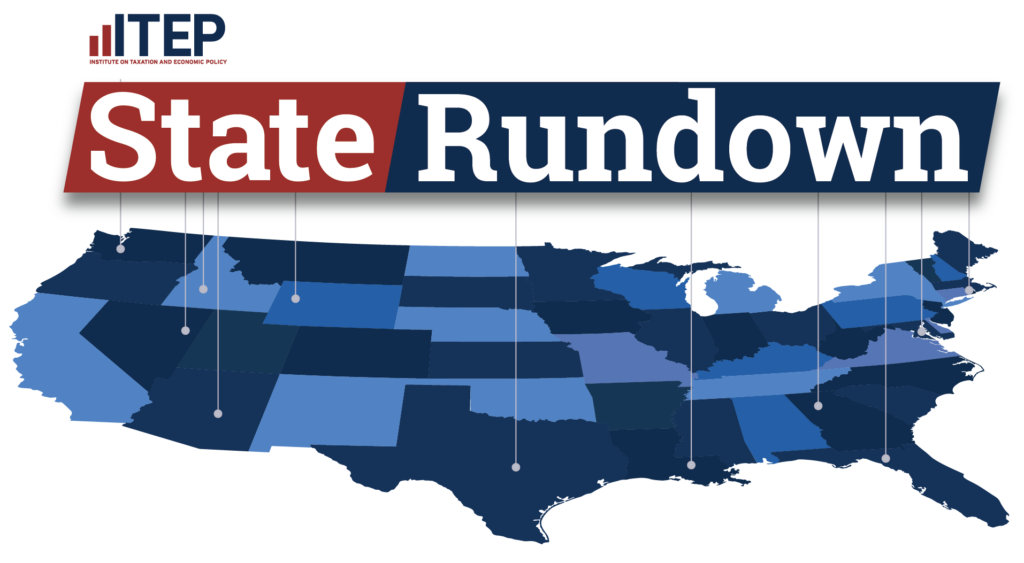An individual savings account can serve as an emergency reserve – a financial cushion to sustain yourself in the event of an emergency. “Rainy day” funds are much like individual saving accounts, but on a statewide scale. Lawmakers use rainy day funds to set aside state tax revenue during periods of economic growth for use when revenue shortfalls make it difficult to provide critical public services. Well-structured rainy day funds allow states to save sufficient revenue in good years that can later be used to shore up revenue in lean years.
Rainy day funds are a necessary component of a responsible state budget. They allow states to align their tax and spending needs over the business cycle. This approach is essential because taxes and public spending often operate on different cycles. When the economy falters and slows down, tax revenue also slows. State income taxes decline as a result of falling incomes, and sales taxes do the same when families are forced to make fewer purchases. However, the need for vital public services such as education and transportation does not diminish when the economy declines. Quite the opposite – declining incomes actually increase the need for many areas of public spending, such as health care and safety net services.
Today all but four states – Colorado, Illinois, Kansas, and Montana – have rainy day funds in place, but few states have created a fund that is truly adequate in bridging fiscal shortfalls. When states do not have a financial cushion in place large enough to cover budget shortfalls, policy makers are faced with tax increases or potentially painful budget cuts. A well-designed rainy day fund can help lessen the need for difficult budget decisions.
In years past, many states have found themselves with too little available in their rainy day funds to shield them from economic downturns. Rather than waiting for another crisis to occur, states should make structural improvements to their rainy day fund policies when their economies are growing, so that they will be better prepared for inevitable economic downturns.
Important design features of state rainy day funds include:
Rules for deposit: Under what circumstances must lawmakers deposit revenue into the fund?
Most states specify conditions under which deposits will be automatically made, although the ways in which they do so vary. Some states rely on the difference between actual and projected revenue – making their determination based on forecast error. Others tie rainy day deposits to underlying economic or revenue conditions. The most common approach, used by twenty-one states, is to link rainy day fund deposits to a state’s year-end surplus.[i] However, while a useful step, this process is not as reliable as it sounds. Because deposits are made at the end of the year, all other spending priorities come first. As a result, rainy day fund savings become an afterthought, making saving a low budget priority. Lawmakers can easily avoid depositing revenue into the rainy day fund by spending all surplus revenue before the end of the fiscal year. Worse yet, a few states have no rules specifying conditions when rainy day fund deposits must be made, and allow lawmakers to deposit revenue when it suits them. In general, these types of rainy day funds are likely to be chronically underfunded.
A more effective approach is to require annual deposits when revenue growth exceeds a certain threshold, ensuring that deposits are made when state revenue grows. For example, Virginia’s formula-based deposits are connected to changes in its revenue stream. Similarly, Massachusetts links its deposits, which grow with the economy, to a specific revenue source – the state’s capital gains tax. While these types of deposit rules encourage the building of a robust rainy day fund, they must be designed carefully. If the threshold mandating deposits is too low, lawmakers may be forced to deposit revenue in the rainy day fund at a time when they cannot afford to set funds aside.
Size limits: Is there a limit, or cap, on the size of the fund?
Nearly all states impose limits on the amount of revenue that can be placed in their rainy day fund. For years a commonly cited rule of thumb was that a fund capped at five percent of a state’s budget should be sufficient to ride out an economic recession. However, the experience of states during recent downturns suggests that a 5 percent limit can result in a rainy day fund that is far too small to cope with extended revenue shortfalls. Eliminating or raising overly restrictive caps on fund size could help states properly fund their reserves and prepare themselves for unexpected events.
Thirty-three states and the District of Columbia have caps of less than 15 percent of their budget. Of those, 19 states and the District of Columbia have caps below 10 percent and 13 states have caps set at or below the 5 percent mark.[ii] These caps limit states’ ability to grow reserves in line with their revenue trends.
Rules for withdrawal: How difficult is it to withdrawal funds?
In most states, a simple majority of lawmakers can vote to use the rainy day fund. However, some states require a supermajority of 60 percent or more. Many states also limit the amount that can be withdrawn in any given year. All such limits make rainy day funds less flexible and increase the likelihood that state lawmakers will have to rely on tax increases or spending cuts to weather a recession. Excessive constraints on withdrawals make the rainy day fund less flexible, and valuable, as a fiscal policy tool. Many states could benefit from reviewing their rainy day fund policies to specify their policy goals and provide clarity for when it is appropriate to withdraw money.
Rules for replenishing funds: How quickly must your state’s fund be replenished after a withdrawal?
Replenishment rules go hand in hand with withdrawal rules. The more immediate the requirement for replenishment, the less flexible rainy day funds are in dealing with fiscal shortfalls. Some states require rainy day fund withdrawals to be paid back promptly. This constraint can reduce the usefulness of rainy day funds. Forcing replenishment can deter withdrawals for fear that repayment is imminent, and will soon require the same sort of painful spending cuts that rainy day funds are designed to prevent.
An adequate, accessible rainy day fund is a vital tool to help states weather economic storms and lessen the need for temporary taxes and budget cuts. However, deposits into state rainy day funds should not come at the cost of inadequate funding and support of critical public services. State rainy day funds are at their best when the need to save is carefully balanced against spending priorities. When this happens, rainy day funds are an indispensable part of a responsible state budget.
[i] “Building State Rainy Day Funds: Policies to Harness Revenue Volatility, Stabilize Budgets, and Strengthen Reserves”, The Pew Charitable Trusts. July 15, 2014. http://www.pewtrusts.org/~/media/Assets/2014/07/SFH_Rainy-Day-Fund-Deposit-Rules-Report_ARTREADY_v9.pdf
[ii] McNichol, Elizabeth C. “When and How States Should Strengthen Their Rainy Day Funds”, Center on Budget and Policy Priorities (CBPP). April 16, 2014. http://www.cbpp.org/research/state-budget-and-tax/when-and-how-states-should-strengthen-their-rainy-day-funds





